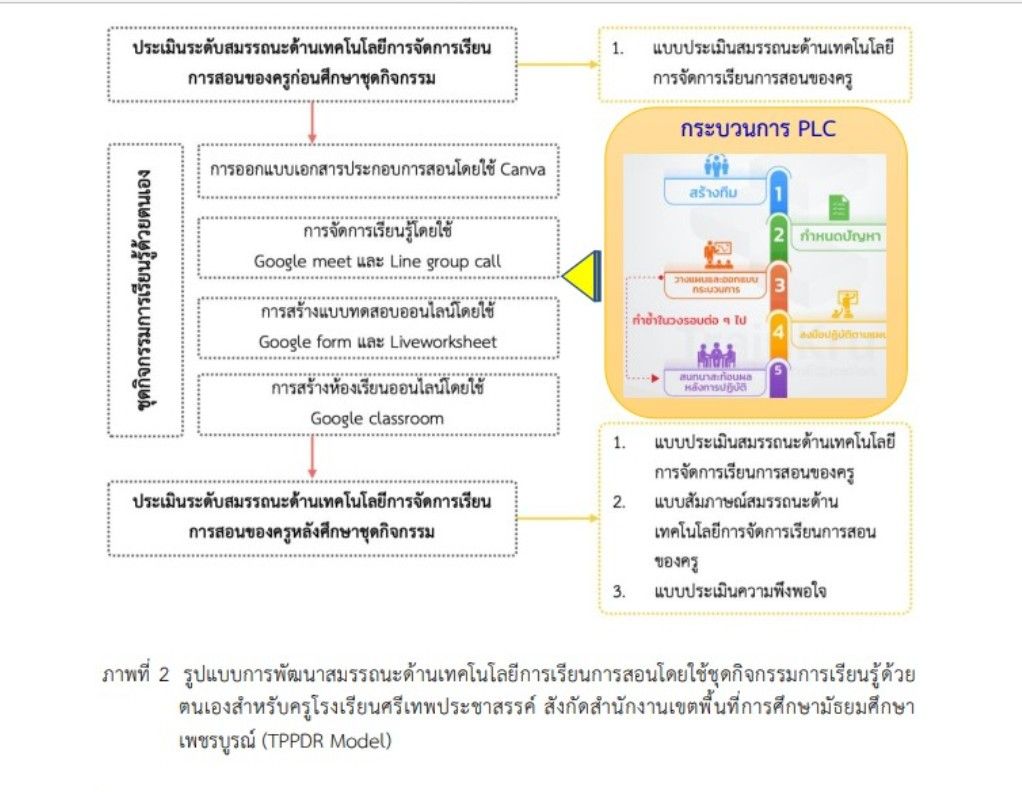การวิจัยและพัฒนาสมรรถนะด้านเทคโนโลยีการเรียนการสอนโดยใช้ชุดกิจกรรม การเรียนรู้ด้วยตนเองสำหรับครูโรงเรียนศรีเทพประชาสรรค์ สังกัดสำนักงานเขตพื้นที่การศึกษามัธยมศึกษาเพชรบูรณ์
Main Article Content
บทคัดย่อ
การวิจัยและพัฒนาครั้งนี้มีวัตถุประสงค์ 1) เพื่อศึกษาความต้องการจำเป็นในการพัฒนาสมรรถนะด้านเทคโนโลยีการเรียนการสอนของครู 2) เพื่อพัฒนาชุดกิจกรรมการเรียนรู้ด้วยตนเองสำหรับการพัฒนาสมรรถนะด้านเทคโนโลยีการเรียนการสอนของครู 3) เพื่อเปรียบเทียบระดับสมรรถนะด้านเทคโนโลยีการเรียนการสอนของครูก่อนและหลังการศึกษาชุดกิจกรรมการเรียนรู้ด้วยตนเองของครู 4) เพื่อศึกษาความพึงพอใจของครูที่มีต่อชุดกิจกรรมการเรียนรู้ด้วยตนเองสำหรับครู โรงเรียนศรีเทพประชาสรรค์ สังกัดสำนักงานเขตพื้นที่การศึกษามัธยมศึกษาเพชรบูรณ์ กลุ่มเป้าหมายในงานวิจัยนี้คือครูและบุคลากรทางการศึกษา จำนวน 60 คน ปีการศึกษา 2564 และเครื่องมือที่ใช้ในการวิจัยครั้งนี้ ได้แก่ แบบสอบถาม และแบบประเมินสมรรถนะครู สถิติที่ใช้ในการวิเคราะห์ข้อมูล คือ ค่าร้อยละ ค่าเฉลี่ย ค่าส่วนเบี่ยงเบนมาตรฐาน การทดสอบที และค่าดัชนีความต้องการจำเป็น ผลการวิจัย พบว่า 1) ความต้องการจำเป็นในการพัฒนาสมรรถนะด้านเทคโนโลยีการเรียนการสอนของครูเรียงจากมากไปน้อย คือ การใช้เทคโนโลยีสารสนเทศในการจัดการเรียนรู้ การใช้เทคโนโลยีในการพัฒนาผู้เรียน การใช้เทคโนโลยีในการผลิตสื่อนวัตกรรมที่ใช้ในการจัดการเรียนรู้ การใช้เทคโนโลยีในการวัดและประเมินผลการเรียนรู้ และการใช้เทคโนโลยีในการสร้างปฏิสัมพันธ์และสื่อสารกับผู้เรียน 2) ชุดกิจกรรมการเรียนรู้ด้วยตนเองมีความเหมาะสมและความสอดคล้องในการพัฒนาสมรรถนะด้านเทคโนโลยีการเรียนการสอนของครู 3) ระดับสมรรถนะด้านเทคโนโลยีการเรียนการสอนของครูหลังการศึกษาชุดกิจกรรมการเรียนรู้ด้วยตนเองสูงกว่าก่อนเรียนอย่างมีนัยสําคัญทางสถิติที่ระดับ .05 และสมรรถนะด้านเทคโนโลยีการเรียนการสอนของครูอยู่ในระดับเชี่ยวชาญ และ4) ความพึงพอใจของครูที่มีต่อชุดกิจกรรมการเรียนรู้ด้วยตนเองอยู่ในระดับมาก
Article Details
เอกสารอ้างอิง
กระทรวงเทคโนโลยีสารสนเทศและการสื่อสาร. (2554). กรอบนโยบายเทคโนโลยีสารสนเทศและการสื่อสาร ระยะ พ.ศ. 2554-2563 ของประเทศไทย (ICT 2020). กรุงเทพฯ: ศูนย์เทคโนโลยีสารสนเทศและการสื่อสาร.
กระทรวงศึกษาธิการ. (2564). แนวทางการเปิดเรียน On site. https://drive.google.com/file/d/1CHRDdjCGcNSDr1JxKeo6kybynDx_KdnR/view
กระทรวงศึกษาธิการ. (2553). หลักสูตรแกนกลางการศึกษาขั้นพื้นฐาน พุทธศักราช 2551. พิมพ์ครั้งที่ 3. กรุงเทพมหานคร : โรงพิมพ์ชุมนุมสหกรณ์การเกษตรแห่งประเทศไทย จำกัด.
กระทรวงศึกษาธิการ. (2556). แผนพัฒนาการศึกษาของกระทรวงศึกษาธิการ ฉบับที่สิบเอ็ด พ.ศ. 2555– 2559. กรุงเทพฯ: สำนักงานปลัดกระทรวงศึกษาธิการ.
กฤษมันต์ วัฒนาณรงค์. (2554). นวัตกรรมและเทคโนโลยีเทคนิคศึกษา. พิมพ์ครั้งที่ 2 กรุงเทพมหานคร : ศูนย์ผลิตตําราเรียน มหาวิทยาลัย เทคโนโลยีพระจอมเกล้าพระนครเหนือ.
กุศยา แสงเดช. (2545). คู่มือพัฒนาสื่อการเรียนการสอนที่เน้นผู้เรียนเป็นสําคัญระดับประถมศึกษา. กรุงเทพมหานคร : สำนักพิมพ์แม็ค.
แกมกาญจน์ สมประเสริฐศรี และคณะ. (2554) เทคโนโลยีสารสนเทศและการสื่อสารเพื่อการเรียนรู้ตลอดชีวิต : เอกสารประกอบการสอน. มหาวิทยาลัยมหาสารคาม.
จิราภรณ์ พรหมทอง. (2559). การพัฒนาตนเองให้เป็นบุคคลแห่งการเรียนรู้เพื่อเข้าสู่ศตวรรษที่ 21 Self Development to be a Learning Person in the 2 1st Century. วารสารวิชาการมหาวิทยาลัยฟาร์อีสเทอร์น, 10(2), 63-72.
เจริญวิชญ์ สมพงษ์ธรรม และคณะ. (2553). การศึกษาแนวโน้มคุณลักษณะของครูไทยในทศวรรษหน้า.กรุงเทพมหานคร : สำนักงานเลขาธิการคุรุสภา.
ชวลิต ชูกําแพง. (2553). การวิจัยหลักสูตรและการสอน. พิมพครั้งที่ 2. มหาสารคาม : มหาวิทยาลัย มหาสารคาม.
ชัชรินทร์ ชวนวัน. (2552). รูปแบบการประเมินสมรรถนะข้าราชการ สํานักงานปลัดกระทรวงศึกษาธิการ. วารสารวิชาการมหาวิทยาลัยอีสเทิร์นเอเชีย, 5(2), 7-12.
ชัยยงศ์ พรหมวงศ์ (2556). การทดสอบประสิทธิภาพสื่อหรือชุดการสอน. วารสารศิลปากรศึกษาศาสตร์วิจัย, 5(1). สืบค้น http://inno-sawake.blogspot.com/2008/07/1.html
ชูศรี วงศ์รัตนะ. (2550). เทคนิคการใช้สถิติเพื่อการวิจัย. นนทบุรี : ไทยเนรมิตกิจอินเตอร์โปรเกรสซิฟ.
ฐิติพัฒน์ พิชญธาดาพงศ์. (2548). การพัฒนาระบบสมรรถนะของกรมการแพทย์กระทรวงสาธารณสุข. เอกสารประกอบการประชุมเชิงปฏิบัติการ. กรุงเทพมหานคร : ปูนซีเมนต์ไทย.
ณรงค์วิทย์ แสนทอง. (2550). มารู้จัก Competency กันเถอะ. พิมพ์ครั้งที่ 3. กรุงเทพฯ : เอช อาร์ เซ็นเตอร์.
มหาวิทยาลัยศรีนครินทรวิโรฒ (2557). โครงการบริการวิชาการเพื่อการพัฒนาสมรรถนะด้าน ICT ครั้งที่ 15. กรุงเทพฯ: สำนักคอมพิวเตอร์ มหาวิทยาลัยศรีนครินทรวิโรฒ.
วาสนา สีลาภเกื้อ. (2555). สมรรถนะด้านเทคโนโลยีสารสนเทศและการสื่อสารที่จำเป็น ของบุคลากรสำหรับ การทำงานในมหาวิทยาลัย: กรณีศึกษาบุคลากรสายสนับสนุนของมหาวิทยาลัยสงขลานครินทร์. วิทยานิพนธ์ปริญญาวิทยาศาสตรมหาบัณฑิต, มหาวิทยาลัยสงขลานครินทร์.
วิเชียร ธำรงโสตถิสกุล. (2560). บทสะท้อนแนวคิดว่าด้วยชุดการสอน ชุดกิจกรรมการเรียนรู้ และชุดการเรียนรู้. วารสารศึกษาศาสตร์ มหาวิทยาลัยนเรศวร, 19(3), 356-369.
สำนักงานคณะกรรมการการศึกษาขั้นพื้นฐาน. (2564). แนวทางการเตรียมการเปิดภาคเรียนที่ 2 ปีการศึกษา 2564 ภายใต้สถานการณ์การแพร่ระบาดของโรคติดเชื้อไวรัสโคโรนา 2019 (Covid-19). https://www.surat2.go.th/2021/files/com_news_manual.
สำนักงานคณะกรรมการส่งเสริมวิทยาศาสตร์ วิจัยและนวัตกรรม (สกสว.). (2564). รูปแบบการพัฒนาทักษะทางเทคโนโลยีสารสนเทศและการสื่อสารของครูเพื่อสร้างการเรียนรู้ของผู้เรียนในศตวรรษที่ 21. https://researchcafe.org/communications-technology-competencies-for-thai-teachers-in-the-21st-century/
อุบลรัตน์ หริณวรรณ. (2557). การเสริมสร้างสมรรถนะครูด้านเทคโนโลยีสารสนเทศทางการศึกษาโดยใช้การ เรียนรู้แบบแลกเปลี่ยนเรียนรู้. วิทยานิพนธ์ปริญญาดุษฎีบัณฑิต, มหาวิทยาลัยเทคโนโลยีพระจอม เกล้าพระนครเหนือ.
Anderson, J. (2010). ICT TRANSFORMING EDUCATION: A Regional Guide. Thailand: UNESCO Bangkok.
Commission on Information and Communication Technology. (2010). National ICT Competency Standard (NICS) Basic. http//www.ncc.gov.ph/nics/files/NICS-Basic.pdf
Crosley, H. (2007). Effects of Traditional Teaching vs a multisensory Instructional package on the science achievement and attitudes of English language learners middle-school students. Ph.D. dissertation , school of education, faculty of the department of the division of administrative and instructional leadership, st. john’s University.
Devito, A. & Gerald, H. K. (1976). Creative Sciencing Ideas Activities for Teacher and Children. Little: Brown and Company.
Hong Kong Education City. (2005). Chief executive's award for teaching excellence teachers association (ATETA) and The Hong Kong association for computer education (HKACE). http://www.hkedcity.net/article/ec-hotpost/23apr10/
Hongthong, K. (2003). The development of learning package toward the community law for ninth grade student. Master thesis, Silpakorn University.
International Society for Technology in Education. (2007). Preparing Teachers to Use Technology. U.S Department of Education’s Preparing: PBS Teacher Line.
Marksub, V. (2012). Development of Science Learning Packages for Secondary Students by Utilizing the Ekkamai Science Center for Education. Master thesis. Bangkok: Srinakharinwirot University.
Maryland State Department of Education. (2002). Maryland Teacher Technology Standards. Maryland: Office of the Deputy State Superintendent for Finance and Administration.
Partnership for 21st Century Skills. (2002). Learning for the 21stCentury: A Report and Mile Guide for 21st Century Skills. http://www. 21st centuryskills.org.
UNESCO. (2008). ICT Competency Standards for Teachers. United Kingdom: United Nations Educational, Scientific and Cultural Organization.
UNESCO. (2011). ICT Competency Framework for Teachers. The United Nations Educational, Scientific and Cultural Organization 7, place de Fontenoy, 75352 PARIS 07 SP.


